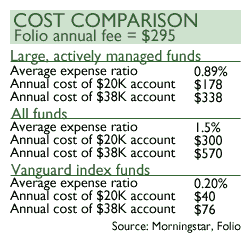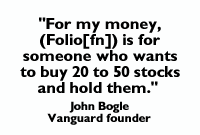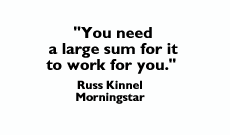|
Folios: a new way to invest
|
 |
June 2, 2000: 6:05 a.m. ET
Online brokerage offerings are 'intriguing,' fund experts say
By Staff Writer Jeanne Sahadi
|
NEW YORK (CNNfn) - For those disenchanted with mutual funds -- their cost, restrictions on when they can be bought and sold, once-a-day pricing or investors' inability to control the tax bite they impose -- there's a new choice.
Joining a host of other alternatives to traditional fund investing -- such as exchange-traded shares and, for those wealthy enough, individually managed accounts -- Folio[fn], a new online brokerage, seeks to give investors the advantages of stocks with the diversification of mutual funds.
Folio[fn]'s goal is to "provide investors with an opportunity to rethink the way they approach the market," said company founder Steven Wallman, a former commissioner with the Securities and Exchange Commission.
Fund experts and former Vanguard chairman John Bogle have called the enterprise "intriguing" and "formidable." But they, along with Wallman, also say it's not necessarily for everyone.
From fund to folio
Folio[fn], which only recently opened to the public in May, differs from mutual funds in a number of ways.
When you buy a fund, you have no say in the fund's holdings, nor do you own the underlying shares. There may be minimum investment requirements and investors pay an expense ratio, which in the case of actively managed funds can total several hundred dollars a year depending on your account size, not including any one-time commissions to buy the fund.
 With Folio, for a flat fee of $295 a year and no minimum investment, investors can create up to three baskets -- or folios -- of up to 50 stocks each and customize them in accordance with their investment goals and risk tolerance. With Folio, for a flat fee of $295 a year and no minimum investment, investors can create up to three baskets -- or folios -- of up to 50 stocks each and customize them in accordance with their investment goals and risk tolerance.
Based on the criteria you choose, the system creates a folio for you or you can choose from the more than 60 "ready-to-go" folios. The pre-selected folios come in several varieties based on market indexes, investment style, sector, risk, geography and social issues.
The shares in a folio are owned by you and may be sold off individually. So, for instance, if you want a Dow 30 folio, but don't want to own Home Depot and Microsoft, you don't have to include them. Likewise, if you have an aversion to Amazon, but want access to the rest of the Internet sector, you can buy an Internet folio without it.
Take control of taxes
Since you control turnover in your folio, you can also better control the tax implications on your investments.
With actively managed funds, portfolio managers buy and sell stocks as they need to, sometimes creating large capital gains distributions on which shareholders must pay taxes regardless of how long they have owned the fund -- or even if the fund ends the year in the red.
Folio[fn] has tools that alert you to the capital gains and losses you have incurred with each of the stocks in your folios, and gives you options to adjust your holdings to minimize or maximize your gains and losses.
Trading options
Lower cost trading options are another potential advantage.
With Folio, you can buy or sell part or all of your baskets up to twice a day for no extra charge; but you must place your order in the morning by 10:15 a.m. and in the afternoon by 2:45 p.m. The company will execute that order within an hour of the window closing, but at a randomly chosen time to "stop anyone from trying to game our system," Wallman said.
If you were trading stocks or funds through a broker, you likely would pay commissions for most transactions, which could exceed the $295 you pay Folio[fn] if you executed 24 or more trades a year.
 If, however, you want to execute a folio trade outside the windows the brokerage sets, you will pay a fee of $14.95 per transaction. If, however, you want to execute a folio trade outside the windows the brokerage sets, you will pay a fee of $14.95 per transaction.
You will also pay a commission every time you buy or sell exchange-traded shares, which are similar to index funds but are bought and sold like stocks. That's why experts say it is a costly option for those who invest using a dollar-cost averaging strategy. But one advantage the exchanged-traded shares have over folios, Wallman concedes, is that you can trade them throughout the day and hence are able to time the market more precisely.
Looking for advice?
Folio[fn] does not yet provide advisory services. So at the moment, it is most suitable for people who either know what they want or are willing to use the brokerage's tools to help them think through their needs before investing, Wallman said.
In the meantime, the company is looking at a number of financial-planning tools that allow you to put in specific information about your situation -- for instance, a 47-year-old man with three kids, a $90,000 salary, $150,000 in savings and a $200,000 mortgage.
Wallman, however, doesn't see Folio[fn] replacing the need for professional investment advisers, who he said provide needed services for clients on such matters as asset allocation and retirement planning. And he anticipates a number of advisers will use the system on their clients' behalf.
But one of the reasons he started the company was because he didn't buy into the messages he heard in many investment ads, which conveyed one of two things, he said: Either you are ignorant and need professional help to do your investing, or "the market's a casino, so roll the dice and do it all yourself."
Bogle on Folio
Wallman is also a big believer in diversification, which is why his company allows for up to 50 stocks per folio to insure a broad reach.
"You don't want to put all your eggs in one basket," Wallman said.
And that's where Vanguard founder John Bogle, an outspoken critic of the fund industry's costs and increasingly short-term trading mentality, thinks Folio might be onto something.
"I believe the best strategy is to buy every stock in America and hold it forever. Folio comes close to that," he said.
 He thinks there are two ideal funds investors would do well to own. The first would have the 50 largest U.S. growth stocks and the second would carry 75 of the largest international growth stocks. Both would be evenly weighted, not market-weighted, he said. He thinks there are two ideal funds investors would do well to own. The first would have the 50 largest U.S. growth stocks and the second would carry 75 of the largest international growth stocks. Both would be evenly weighted, not market-weighted, he said.
"For my money, (Folio[fn]) is for someone who wants to buy 20 to 50 stocks and hold them," said Bogle, who said he has talked with Wallman about coming on board but that nothing conclusive has come of those discussions.
A Folio[fn] feature that does not appeal to him and which he believes will not serve investors if exercised is the option to trade twice a day. "Trading makes you a loser in the long run," he said. "Investing is about substance, not noise."
Ode to index and tax-managed funds
Russ Kinnel, an analyst at fund-tracker Morningstar, also sees pluses in Folio[fn] if you have $70,000 or more to invest outside of tax-deferred savings plans and you want more flexibility and tax control in your portfolio.
"You need a large sum for it to work for you," Kinnel said. He noted that Folio[fn]'s annual fee won't beat out the low expense ratios on many no-load index funds or tax-managed funds. At Vanguard, for instance, they run about 0.2 percent, which will cost investors with $20,000 accounts no more than $40 a year.
For different reasons, Wallman, too, said the person with just $10,000 to invest, no specific requirements regarding a fund's holdings - for instance, no tobacco stocks -- and no interest in ever making a trade might be better off in an index fund or other low-cost mutual fund.
Sophisticates only need apply
And despite their advantages, Kinnel said folios at this stage are probably best suited to sophisticated investors because the tool is new and you have to understand how to make it work within your entire portfolio.
Nevertheless, he and others agree its presence presents a challenge to the fund industry to make its investment vehicles cheaper, particularly if the retail market embraces it.
Bogle is confident Vanguard will always be able to compete, but "I think a lot of firms may not be able to," he said. 
|
|
|
|
|
 |

|

